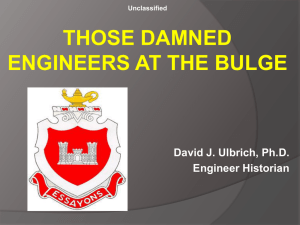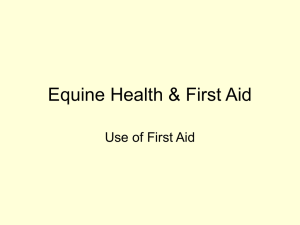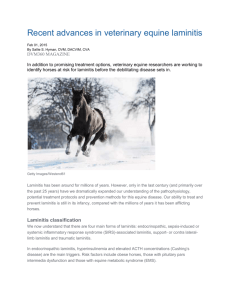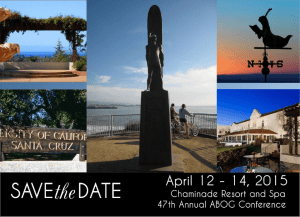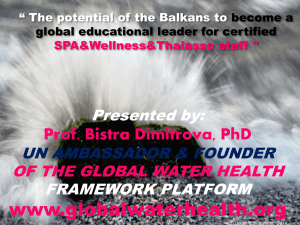Peasebrook Equine Rehab ECB Equine Spa
advertisement
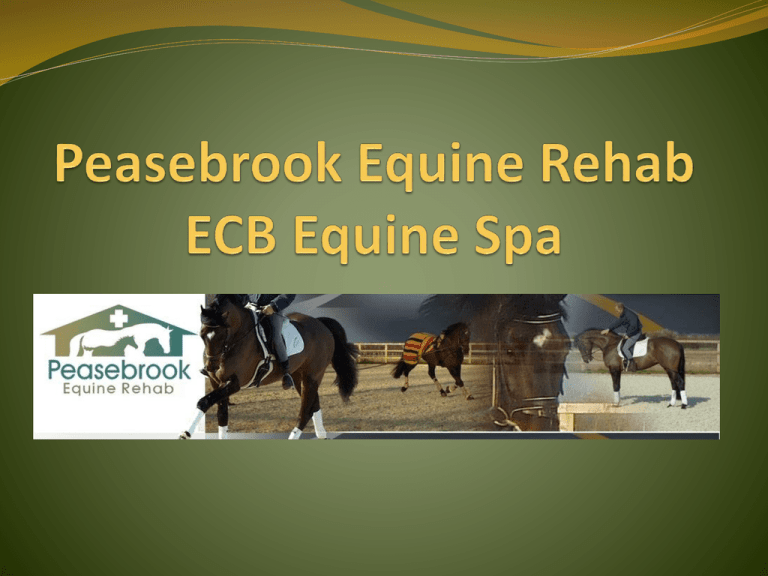
PER ECB Equine Spa ~ The latest development within PER is the fully commissioned ECB Equine Spa ~ Cold water hydrotherapy is used to treat & prevent a multitude of injuries in 2°C / 35°F saltwater. ~ The Spa has successfully addressed virtually all lower leg injuries. ~ Treatment temperature leads to a profound vasoconstriction, reducing inflammation, post treatment the subsequent reperfusion promotes healing. ~ This “Drug Free” therapy can be used for injury prevention & also to increase mobility & reduce swelling in the limbs before & after competitive events & training. ~ The PER ECB Equine Spa is a self contained unit holding 2000 Litres / 530 Gallons. PER ECB EQUINE SPA Peasebrook Equine Rehab Temperature The PER ECB Spa solution is maintained between 2 & 4 C (35 F), to minimise heat & inflammation. This provides analgesic pain management as well as inhibiting enzyme degeneration of tendons post injury. Salt Concentration The salt solution acts as a hypertonic poultice as well as having a natural healing effect on wounds. Water density increases with salt concentration, which in turn increases pressure to aid fluid and water dispersal. Aeration Water aeration has a massaging effect on the leg & increases the dissolved Oxygen content of the spa solution. Depth The depth of the water is proportional to the pressure exerted on the leg, which effect fluid & waste dispersal; this can be varied according to position of injury. Biological Control With water hygiene levels continually being maintained with a combination of fine filtration, chlorination, cold water & salt, the PER ECB Spa allows thousands of successive treatments. These same factors not only prevent further micro-biological infections but actually help treat any pre-existing conditions. Dissolved Oxygen Water temperature below 6 C (48 F) has a higher ability to carry Oxygen & with the ECB solution also being aerated, the Oxygen content is increased dramatically. It is believed that the spa has similar effects on internal leg injuries to the use of hyperbaric chambers in humans; and with topical wounds, reoxygenation allows phagocytes and other natural defence mechanisms to intensify in their therapy and other host defence mechanisms to intensify in their therapy. The therapeutic factors of cold salt hydrotherapy can be used to treat all forms of inflammation within the tissues of the lower limb Tendonitis Injury to superficial digital flexor, check ligament, deep digital flexor. Tendonitis is one of the principle injuries associated with performance horses, as often repair is not fully successful. For example, initial injury may start as a bruise or strain to the collagen fibres, which then become inflamed & further deteriorate under the influence of collagenase. In repair new collagen fibres form, however often form cross links due to lingering swelling which are weak & re-injure. Cold hydrotherapy treatment minimizes the effects of collegenase by keeping the leg temperature lower; thus reducing the swelling allowing collagen fibres to repair neatly. Laminitis In 2009The Austrailian Equine Laminitis research unit’s Professor Chris Pollitt's paper was published into the success of cryotherapy in treating laminitis. The results were conclusive and a success: 'A fantastic breakthrough in the treatment of laminitis. ECB Equine Spa'. This continued reserach by Professor Chris Pollitt, has now proven that regular use of the cold salt hydrotherapy can effectively alleviate the clinical signs and pathology of acute laminitis. Desmitis The suspensory appararus supports the lower leg through attachment to the lower bones, injury is common when horses slip or twist the leg or where over extension of the fetlock occurs regularly during exercise. Injury of the ligament could occur in a similar manner to tendonitis or ligament separation from bone may result in intense inflammation & pain. Repair is slow and replacement collagen must form correctly to prevent injury, hence the importance to keep swelling down for straight collagen repair. Arthritis Bone provides a living scaffold for movement & injury can result in degeneration of bone and joint tissue with a weakening of the bone structure. Inflammation results in swelling & pain & unless the progressive changes are stopped deterioration will continue to worsen with concussion. The use of cold hydrotherapy has been proven to be of a great asset to Arthritic cases. Hoof Injuries Over reach, Abscesses, Bruised soles, Corns, Laminitis, Thrush, Nail Trauma All the different structures that go to make up the hoof can be injured either by concussion, trauma, shoeing or nutrition. Each form results in its own type of inflammation, sometimes with isolated infection. Cold Poultice treatment of the hoof has been a traditional therapy and the spa improves the process in the above injury types. Shin Splints During exercise, pressure on the digital extensor tendon sheath through the cranial aspect of the cannon bone, can cause the attachment of the sheath to the bone to lift in young horses. As exercise increases, the inflammation worsens with fluid separating the sheath and bone further. Spa treatment minimizes the inflammation. Jar Up & Bruising Concussion soreness is a common result where horses work on hard surfaces after lead up exercise on softer going. This may result from a change in the going on grass tracks or change from all weather surfaces to firmer going in racehorses. The bone tissues are stressed and inflammation commences throughout the skeletal structures without showing signs of fluid or swelling. Bursitis / Synovitis Swollen joints, wind galls or wind puffs. Result where stress injury develops in the tissues surrounding joints and ligaments. The synovial membranes produce excess fluid causing the joint or tendon sheaths to swell. The use of cold water hydrotherapy has been proven to significantly assist in the healing and repair of such trauma. Open Wounds & Skin Infection Dermatitis, Greasy Heal, Mud Fever, Rain Scald, to name but a few. Skin infections all commence with abrasion to the skin cells which then allow entry of various microorganisms resulting in inflammation. Both inflammation and the micro organic cause require elimination and cold water hydrotherapy speeds this process, with the salt content of the water acting as a poultice. Many of the artificial surfaces that horses work on are abrasive and can irritate skin on the lower limb. Injury Prevention & the PER ECB Equine Spa Prevention is always better than cure. By regular use of cold salt water hydrotherapy immediately after hard exercise, many of the stressors within tissues are removed before inflammation develops. Cold also significantly improves surface bone density reducing the opportunity for bone stress related injuries to commence. The healing of injuries can be prolonged, with new tissue types being weak and prone to re-injury. Spa treatment resolves injuries faster in two ways. Firstly by keeping the leg temperatures lower it minimises the effect of fibre deteriorating collegenase. Secondly by reducing the swelling, it allows collagen fibres to repair neatly. This reduced convalescence time is beneficial for all the horse and all connected, however the perfect situation to utilise cold water hydrotherapy is within injury prevention.




